Designing a botanical garden is all about creating a delightful space that showcases the beauty and diversity of plant life. It combines art and nature, offering a peaceful retreat for visitors while promoting education and conservation. A well-thought-out layout can enhance the experience, making it easy to appreciate the stunning array of flora and fauna in a harmonious setting.
Incorporating Edible Plants
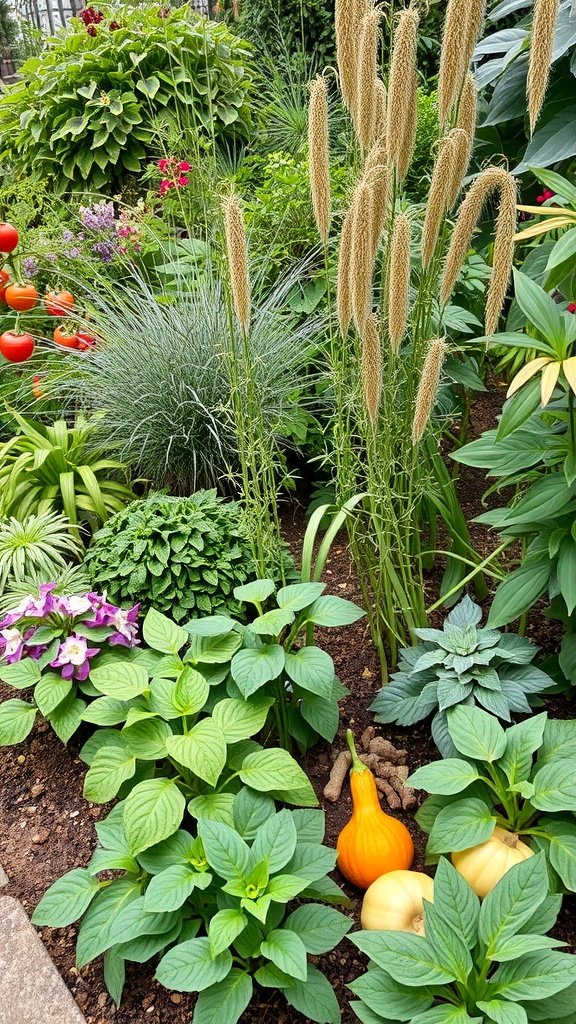
Imagine walking through a vibrant garden filled with colorful plants. This image showcases a delightful mix of edible plants, creating a feast for the eyes and the palate. You can spot bright tomatoes, cheerful squash, and lush greens all thriving together.
Edible plants add a unique charm to any garden design. They not only provide fresh ingredients for your meals but also enhance the overall beauty of the space. The combination of textures and colors from these plants can make your garden feel alive and inviting.
Consider planting herbs like basil or mint alongside your vegetables. They can attract beneficial insects and add fragrance to your garden. Plus, having fresh herbs at your fingertips is a great way to elevate your cooking.
When planning your garden, think about the layout. Grouping plants with similar needs can help them thrive. For instance, tomatoes love sunlight, while leafy greens can tolerate some shade. This thoughtful arrangement can lead to a more productive garden.
Enhancing Biodiversity with Pollinator Gardens
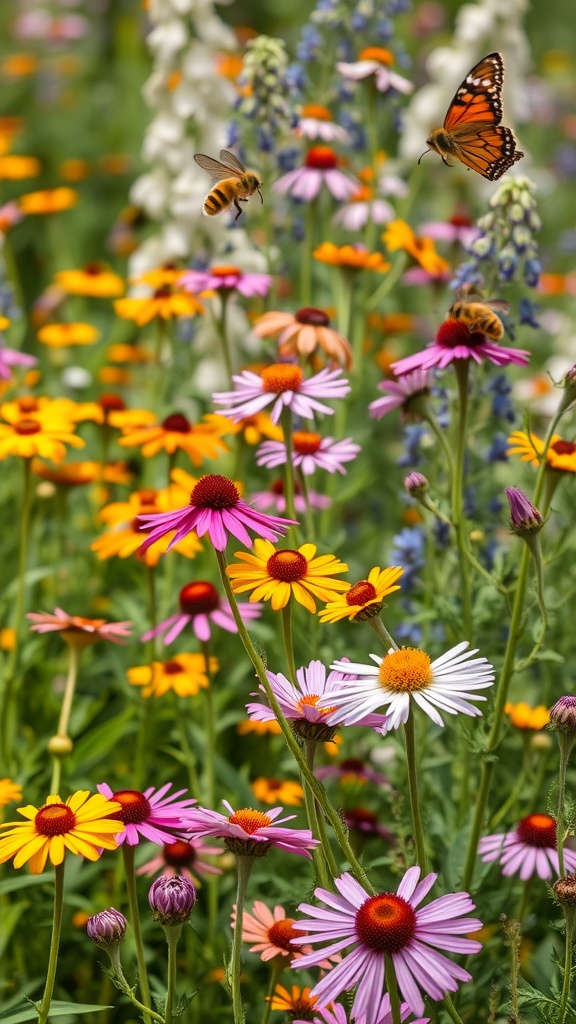
Pollinator gardens are a fantastic way to boost biodiversity in any botanical space. The image shows a vibrant mix of flowers attracting bees and butterflies, which are essential for pollination. These gardens create a lively atmosphere, filled with color and movement.
Incorporating native plants is key. They provide food and habitat for local pollinators. The flowers in the image, with their bright hues, are not just pretty; they play a vital role in supporting the ecosystem. Bees and butterflies thrive in such environments, helping to pollinate not only garden plants but also crops in the surrounding areas.
Creating a pollinator garden is simple. Start by selecting a variety of flowering plants that bloom at different times. This ensures that there’s always something in bloom, providing a continuous food source. The mix of colors and shapes will attract a diverse range of pollinators, enhancing the garden’s beauty and ecological value.
Maintaining a pollinator garden also involves minimizing pesticide use. Chemicals can harm beneficial insects. Instead, consider natural pest control methods. This approach not only protects pollinators but also promotes a healthier garden overall.
Utilizing Vertical Gardens
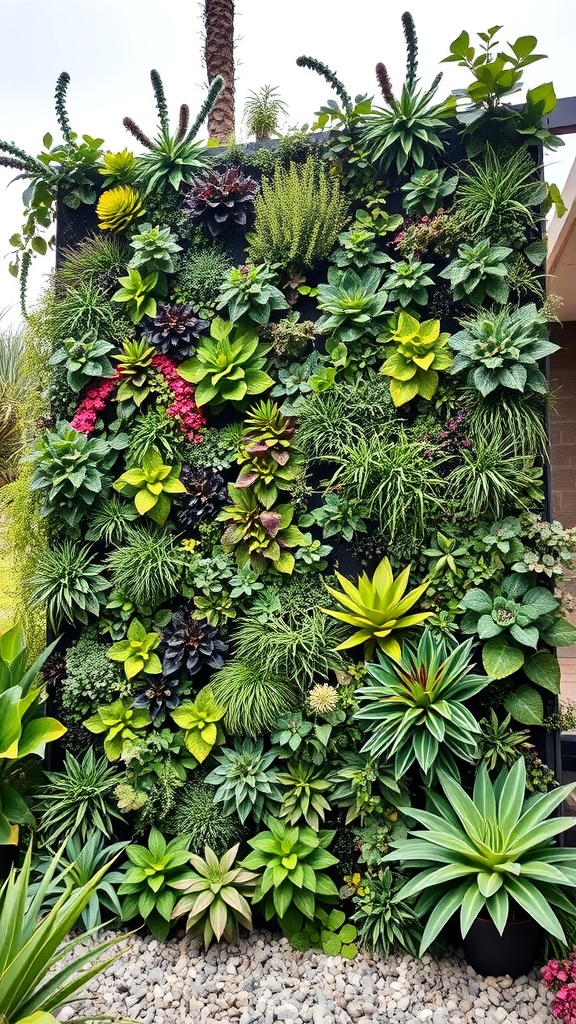
Vertical gardens are a fantastic way to bring greenery into any space, especially when ground space is limited. The image showcases a stunning vertical garden filled with a variety of plants. Each plant contributes to a lush, vibrant display that can transform a plain wall into a living masterpiece.
This design not only adds beauty but also improves air quality. The diverse range of plants, from succulents to leafy greens, creates a dynamic texture and color palette. It’s a great way to incorporate nature into urban settings, making them feel more inviting.
Vertical gardens can be customized to fit any style. Whether you prefer a wild, natural look or a more structured arrangement, the possibilities are endless. They can be installed indoors or outdoors, making them versatile for any environment.
Maintaining a vertical garden is easier than it seems. Regular watering and occasional pruning keep the plants healthy and thriving. Plus, many plants used in vertical gardens are low-maintenance, making them perfect for busy lifestyles.
Designing Pathways for Exploration
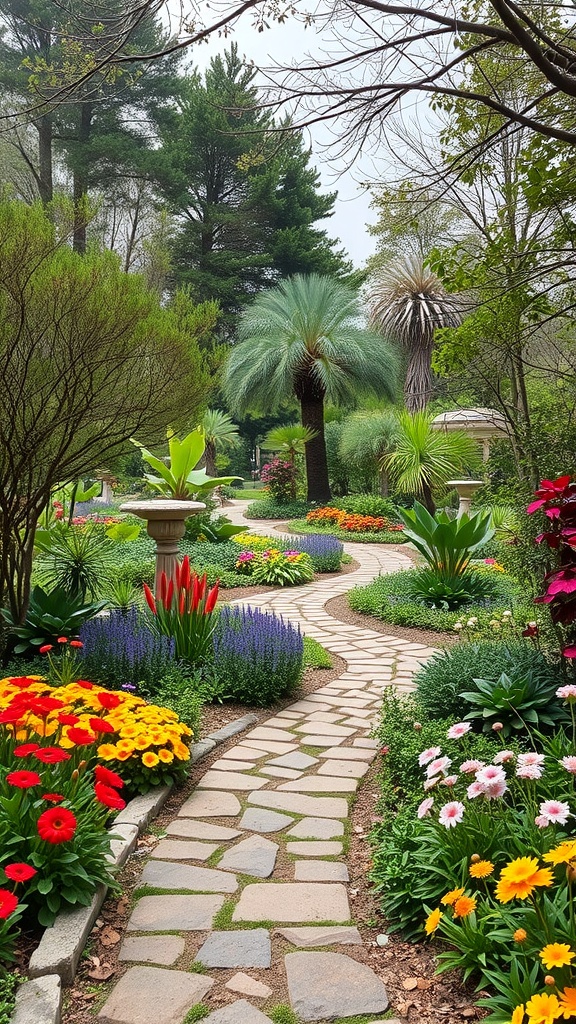
Creating pathways in a botanical garden is key to guiding visitors through a beautiful landscape. The winding stone path in the image invites exploration, leading the eye through vibrant flower beds and lush greenery.
These pathways are not just functional; they enhance the overall experience. The gentle curves create a sense of mystery, encouraging people to wander and discover each unique section of the garden. The colorful blooms along the sides add a cheerful touch, making each step enjoyable.
Incorporating different materials, like stones and gravel, can add texture and interest. The mix of plants, from tall palms to colorful flowers, creates a dynamic environment. This design approach allows visitors to appreciate the diversity of plant life while enjoying a leisurely stroll.
Ultimately, well-designed pathways can transform a simple garden into a delightful exploration space, inviting everyone to take their time and soak in the beauty around them.
Creating a Serene Water Feature
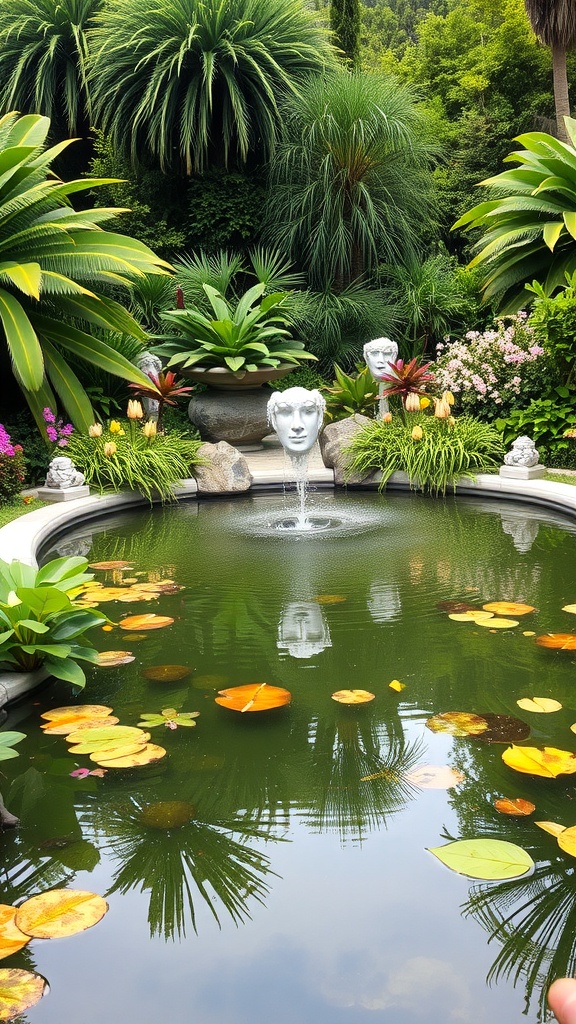
A water feature can be a stunning focal point in any botanical garden. The image showcases a tranquil pond surrounded by lush greenery. The gentle flow of water adds a soothing sound, inviting visitors to relax and enjoy the beauty of nature.
The pond is adorned with floating lily pads, their vibrant colors contrasting beautifully with the deep green water. This creates a serene atmosphere that encourages reflection and peace. Statues peeking out from the edges add an artistic touch, enhancing the garden’s charm.
Incorporating plants around the water feature is essential. The tall, feathery palms and colorful flowers create a lush backdrop, making the area feel alive and vibrant. This combination of elements not only attracts wildlife but also provides a habitat for various species.
When designing your own water feature, think about the size and shape that will best fit your space. Consider adding lighting to highlight the feature at night, transforming it into a magical spot. A well-placed water feature can truly elevate the overall experience of a botanical garden.
Incorporating Native Plant Species
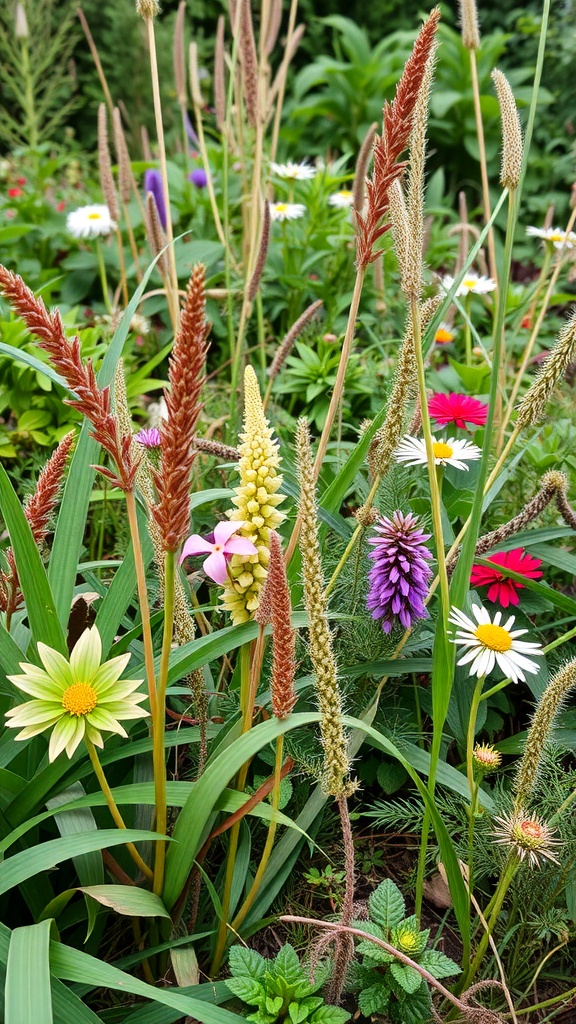
When designing a botanical garden, using native plant species is a fantastic choice. These plants are well-adapted to the local climate and soil, making them easier to care for. The image showcases a vibrant mix of native flowers and grasses, each contributing to the garden’s beauty.
Native plants support local wildlife, including pollinators like bees and butterflies. In the image, you can see various colors and textures that attract these important creatures. This not only enhances the garden’s appeal but also promotes biodiversity.
Choosing native species can also reduce the need for fertilizers and pesticides. This means a healthier environment for everyone. The plants in the image, with their varied heights and shapes, create a dynamic landscape that is visually interesting and ecologically beneficial.
Incorporating native plants into your garden design is a step towards sustainability. It creates a space that is not just beautiful but also functional. The colorful blooms and lush greenery in the image illustrate how native plants can transform any garden into a thriving ecosystem.
Creating Themed Garden Areas
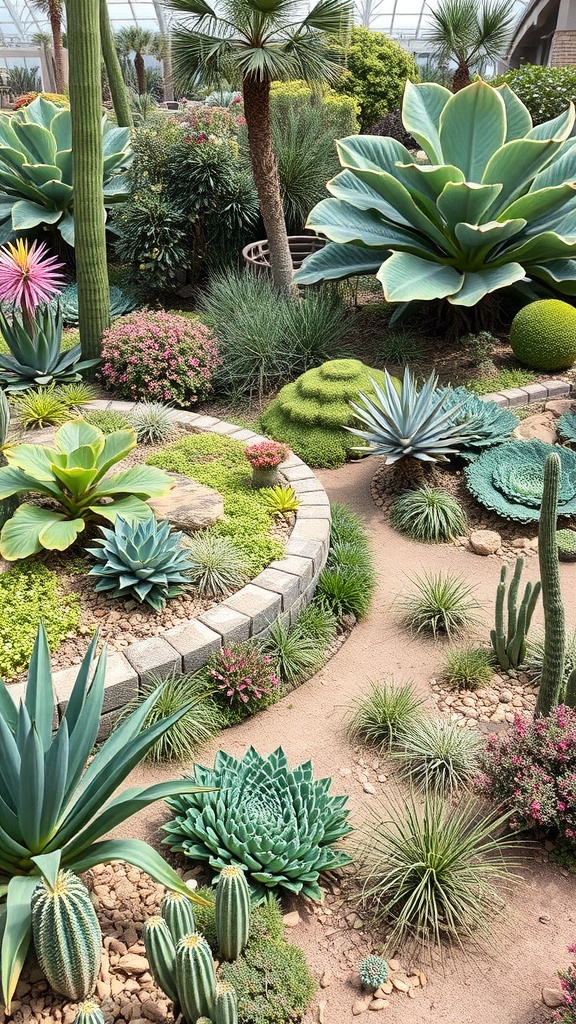
Themed garden areas can bring a unique charm to any botanical garden. They allow visitors to experience different styles and plant types in one location. In the image, we see a stunning display of succulents and cacti, showcasing a desert theme. The variety of textures and shapes creates an inviting and visually appealing space.
Using plants that thrive in similar conditions is key to designing these areas. The arrangement of the succulents, along with the winding path, encourages exploration. Visitors can stroll through and appreciate the diversity of plants, from large agaves to smaller cacti.
Incorporating elements like rocks and gravel adds to the theme and helps with drainage. This design not only looks great but also serves a practical purpose. The vibrant colors of the flowers contrast beautifully with the greens and blues of the succulents, making the area pop.
Creating themed garden areas allows for creativity and personalization. Whether it’s a tropical paradise or a serene zen garden, each theme can tell a story and engage visitors in a different way.
Implementing Sustainable Practices
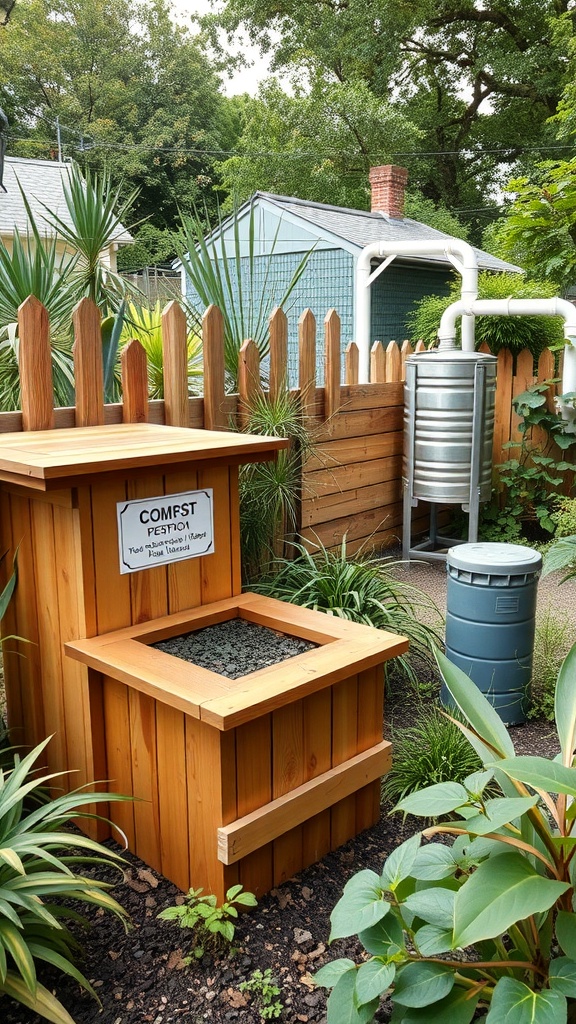
Creating a botanical garden is a wonderful way to connect with nature. One of the best ways to do this is by implementing sustainable practices. The image shows a compost bin, a key element in any eco-friendly garden.
This compost bin is not just a stylish addition; it plays a vital role in recycling organic waste. By composting kitchen scraps and yard waste, you create nutrient-rich soil that benefits plants. This reduces the need for chemical fertilizers, promoting healthier growth.
Rainwater harvesting is another sustainable practice visible in the image. The silver tank collects rainwater, which can be used for irrigation. This method conserves water and reduces reliance on municipal sources. It’s a simple yet effective way to make your garden more sustainable.
Incorporating native plants is also essential. They require less water and are more resistant to local pests. This means less maintenance and fewer chemicals. Together, these practices create a thriving ecosystem that supports local wildlife.
Designing with Focal Points
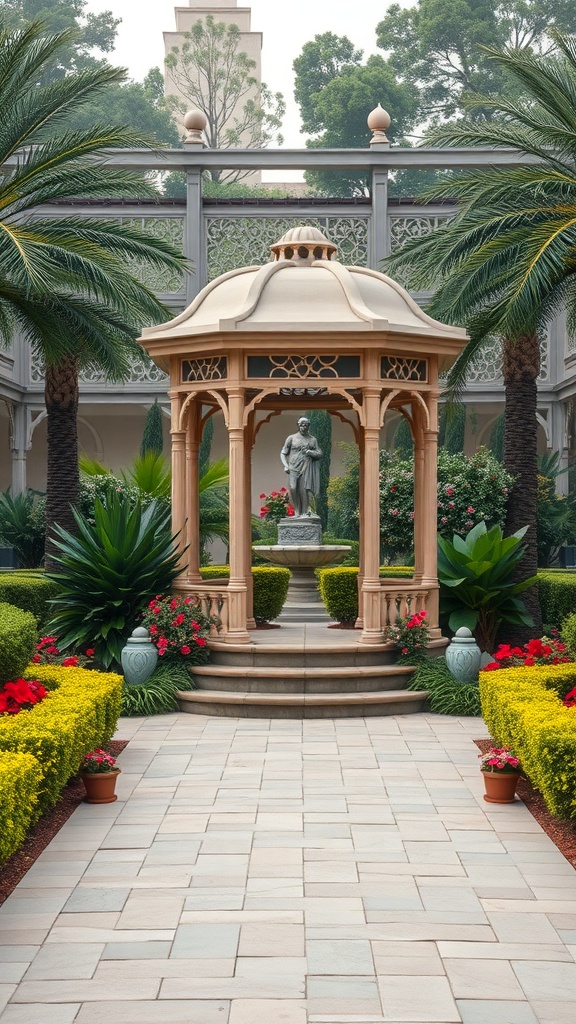
Creating a stunning botanical garden starts with choosing focal points that draw the eye and invite exploration. In this image, a charming gazebo stands at the center, surrounded by lush greenery and vibrant flowers. This structure not only serves as a visual anchor but also offers a place for visitors to pause and appreciate the beauty around them.
The pathway leading to the gazebo is lined with colorful plants, guiding visitors naturally toward the focal point. The use of symmetry in the arrangement of the plants enhances the overall design, making the space feel balanced and inviting. The statue in the gazebo adds an artistic touch, encouraging visitors to linger and take in the details.
When designing your garden, think about how you can create similar focal points. Whether it’s a unique sculpture, a water feature, or a beautifully designed seating area, these elements can transform a simple garden into a captivating experience.
Integrating Art Installations
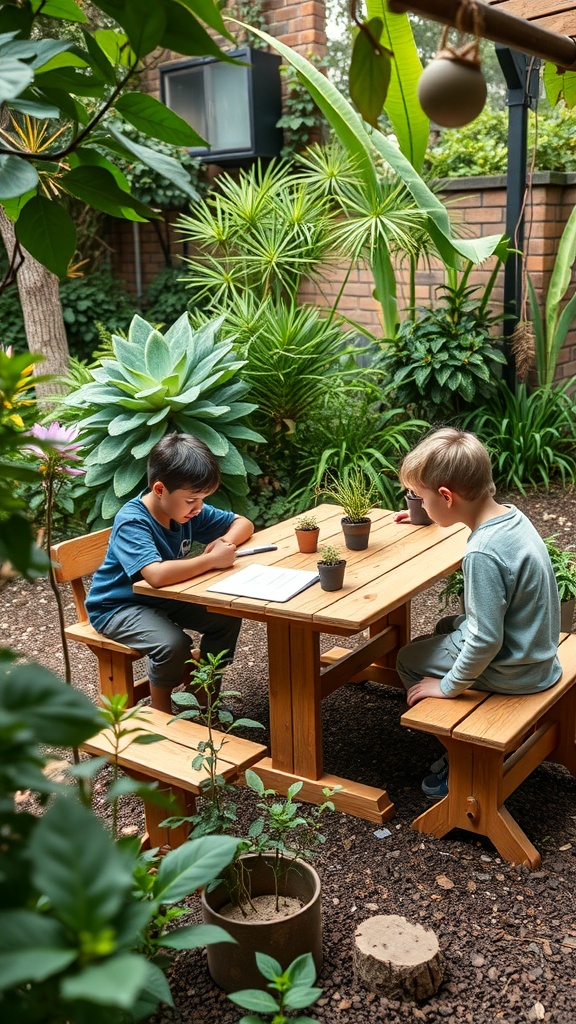
Art installations can bring a unique flair to botanical gardens. They create a dialogue between nature and creativity. The image showcases a collection of sculptures nestled among vibrant flowers and lush greenery.
Each piece tells its own story. The figures, from whimsical to serene, invite visitors to pause and reflect. This interaction enhances the garden experience, making it more than just a stroll through plants.
Incorporating art can also attract a wider audience. Families, art lovers, and nature enthusiasts all find something to appreciate. This blend of art and nature fosters a sense of community and encourages exploration.
As you walk through the garden, the sculptures stand out against the backdrop of colorful blooms. They create focal points that draw the eye and spark curiosity. This thoughtful integration can transform a simple garden visit into an engaging experience.
Creating Educational Spaces
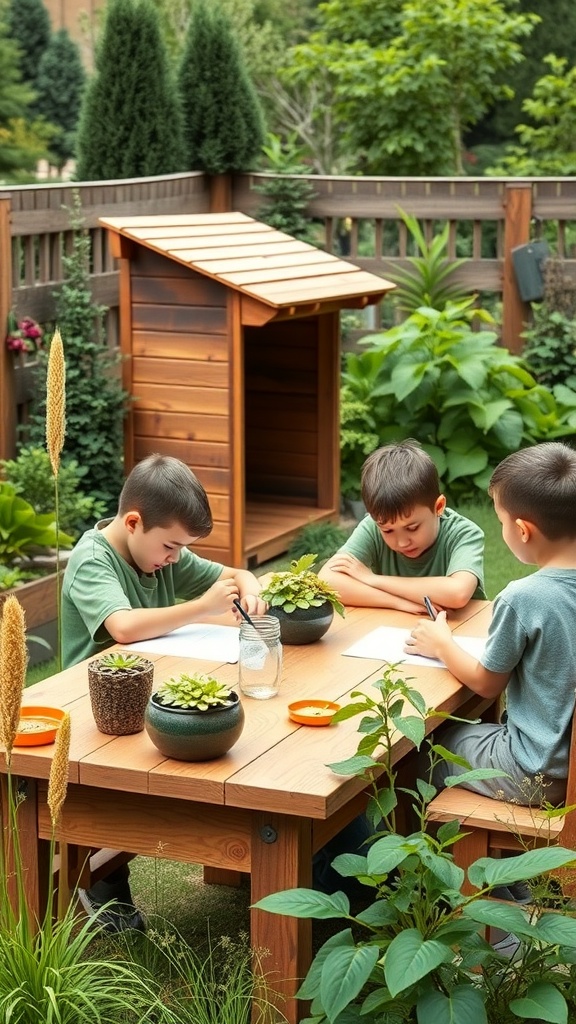
Creating educational spaces in botanical gardens can be a wonderful way to connect people with nature. The image shows a group of individuals gathered around a wooden table in a lush garden setting. They appear to be engaged in a learning activity, surrounded by vibrant greenery.
This kind of environment encourages curiosity and exploration. The natural surroundings provide a perfect backdrop for hands-on learning. Whether it’s studying plant species or understanding ecosystems, these spaces can inspire a love for nature.
Having designated areas for education allows visitors to interact with the flora and fauna in a meaningful way. It’s not just about looking at plants; it’s about understanding their role in our world. Workshops, guided tours, and interactive exhibits can enhance the learning experience.
Incorporating seating and tables, like those in the image, makes it easy for groups to gather and share ideas. This setup fosters collaboration and discussion, making learning a social experience. Overall, educational spaces in botanical gardens can play a key role in promoting environmental awareness and stewardship.
Creating Relaxation Zones
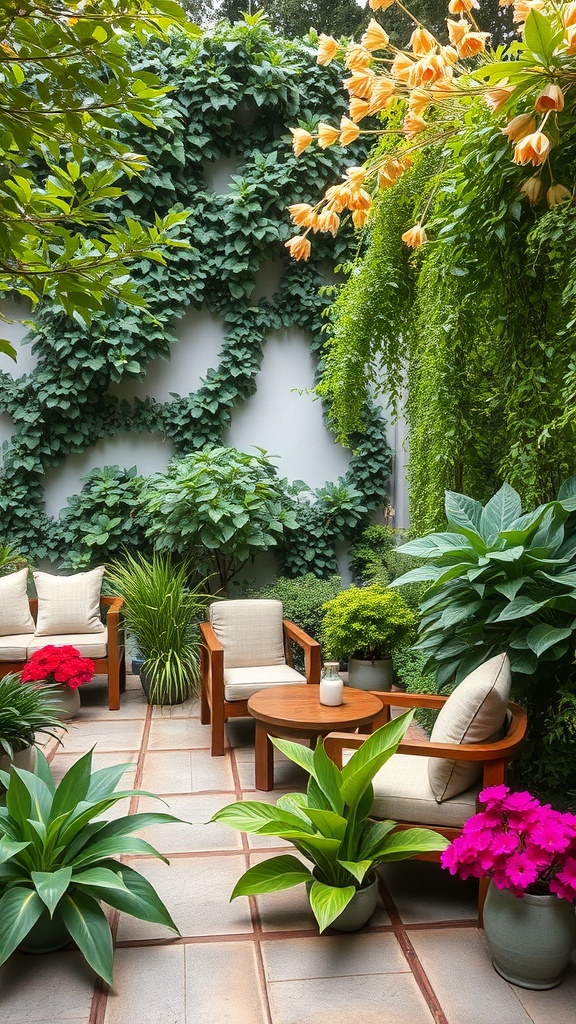
Creating relaxation zones in a botanical garden can transform a simple space into a peaceful retreat. Imagine a cozy area with comfortable seating surrounded by lush greenery and vibrant flowers. This setup invites visitors to unwind and enjoy nature.
The image showcases a lovely seating arrangement with soft cushions, perfect for lounging. The wooden chairs and table blend beautifully with the surrounding plants, making it feel inviting. The colorful blooms add a cheerful touch, enhancing the overall experience.
Incorporating various plants, like ferns and flowering species, not only beautifies the space but also promotes a calming atmosphere. The greenery acts as a natural backdrop, encouraging visitors to relax and take in their surroundings.
Consider adding features like soft lighting or water elements to further enhance relaxation. These details can create a serene environment where people can escape from their busy lives. A well-designed relaxation zone can be a highlight of any botanical garden, offering a perfect spot for reflection and enjoyment.
Designing Seasonal Displays
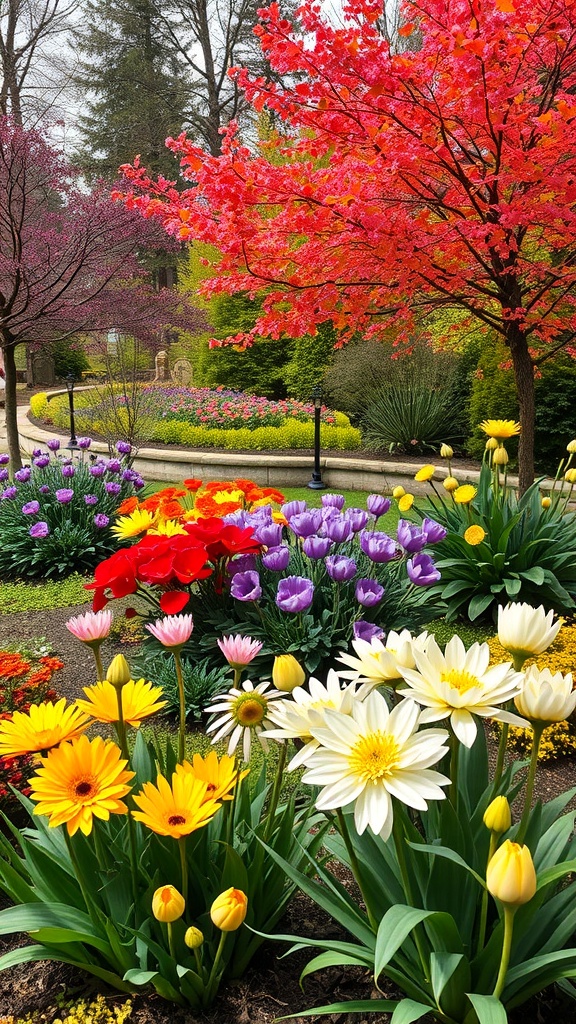
Creating seasonal displays in a botanical garden can be a delightful way to showcase nature’s beauty. The image captures a vibrant scene filled with colorful flowers and trees, each contributing to a stunning visual experience.
In spring, you can see bright yellow daisies and tulips blooming alongside rich purple tulips and striking red flowers. These colors not only attract visitors but also create a cheerful atmosphere. The arrangement of flowers in clusters adds depth and interest, making each section of the garden feel unique.
Incorporating trees with colorful foliage, like the red maple in the background, enhances the seasonal theme. This mix of plants ensures that there’s always something new to see, encouraging visitors to return throughout the year.
Seasonal displays can also include themed elements, such as decorative pathways or garden art, which complement the natural beauty. This thoughtful design invites guests to stroll and enjoy the surroundings, making their visit memorable.
Incorporating Seasonal Aromas
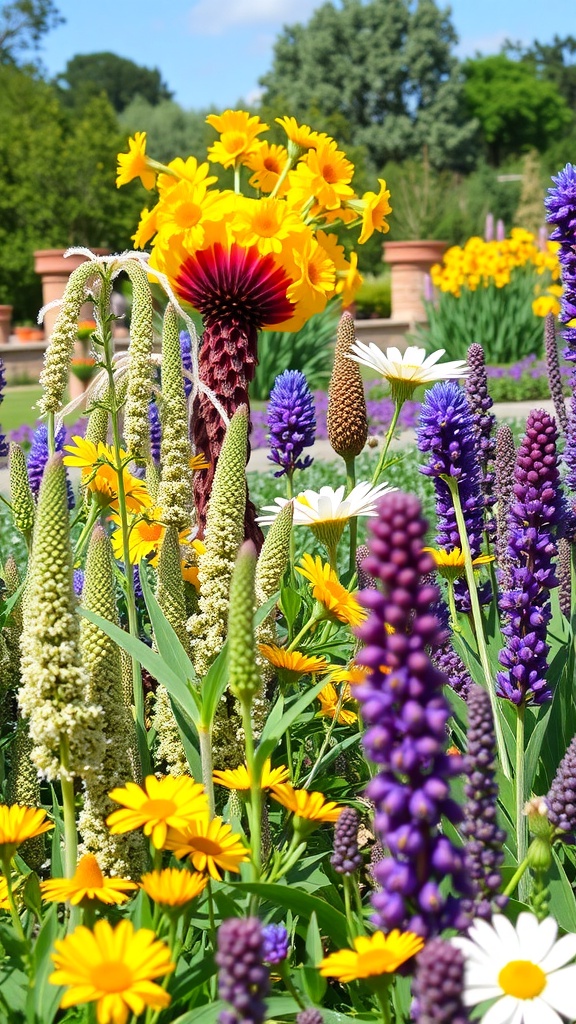
Imagine strolling through a botanical garden filled with vibrant flowers and lush greenery. The image captures a beautiful scene where colorful blooms, like blue delphiniums and cheerful sunflowers, create a feast for the eyes. The path is lined with pots of flowers, inviting visitors to explore and enjoy the scents that fill the air.
Seasonal aromas play a big role in enhancing the garden experience. Each flower brings its unique fragrance, from the sweet scent of blooming roses to the fresh notes of lavender. These scents can evoke memories and emotions, making a visit to the garden even more special.
Incorporating a variety of plants that bloom at different times of the year ensures that there’s always something aromatic to enjoy. For instance, spring might bring the delightful smell of lilacs, while summer could be filled with the warm scent of sunflowers and zinnias. This variety keeps the garden lively and engaging throughout the seasons.
To make the most of these aromas, consider adding pathways that guide visitors through different scented areas. This way, people can experience the changing scents as they walk through the garden. It’s a simple yet effective way to create a memorable visit.
Utilizing Color Theory in Plant Selection
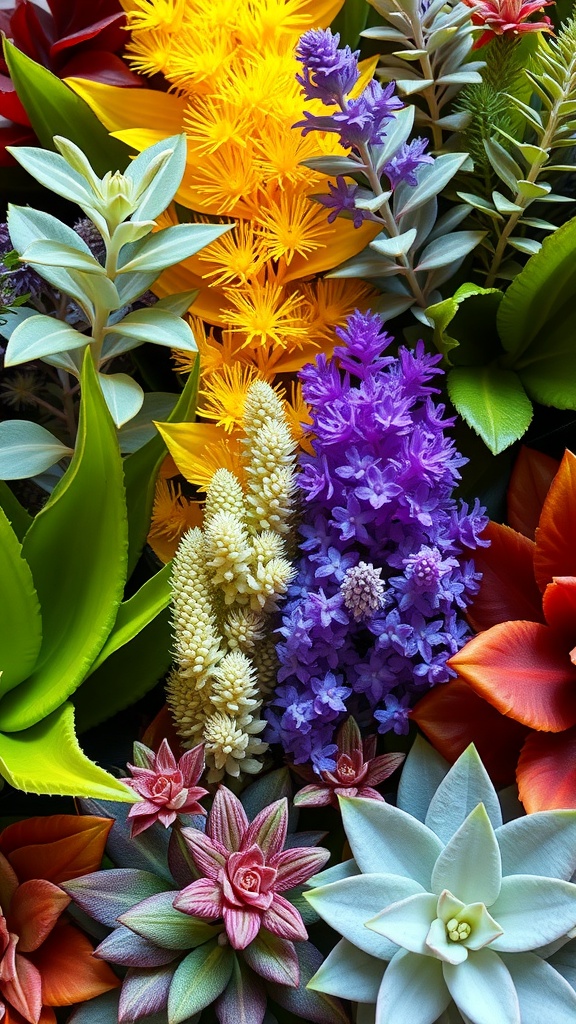
Color plays a big role in how we perceive a garden. In this vibrant image, a mix of plants showcases a stunning array of colors, from bright yellows to deep purples. Each hue can evoke different feelings and set the tone for the space.
When selecting plants, think about how colors interact. Warm colors like reds and yellows can create a lively atmosphere, while cooler tones such as blues and greens offer a calming effect. This balance can make your botanical garden feel inviting and harmonious.
Consider the seasons too. Some plants bloom in spring with bright colors, while others may shine in autumn with rich, warm shades. Mixing these can ensure your garden looks beautiful year-round.
Don’t forget about contrast! Pairing complementary colors can make certain plants stand out. For example, a bright yellow flower against deep green leaves can really pop. This technique draws the eye and adds interest to your garden.
Ultimately, using color theory in plant selection is about creating a space that feels right for you. Whether you want a cheerful, energetic vibe or a serene retreat, the right colors can help you achieve that vision.
Designing for Accessibility
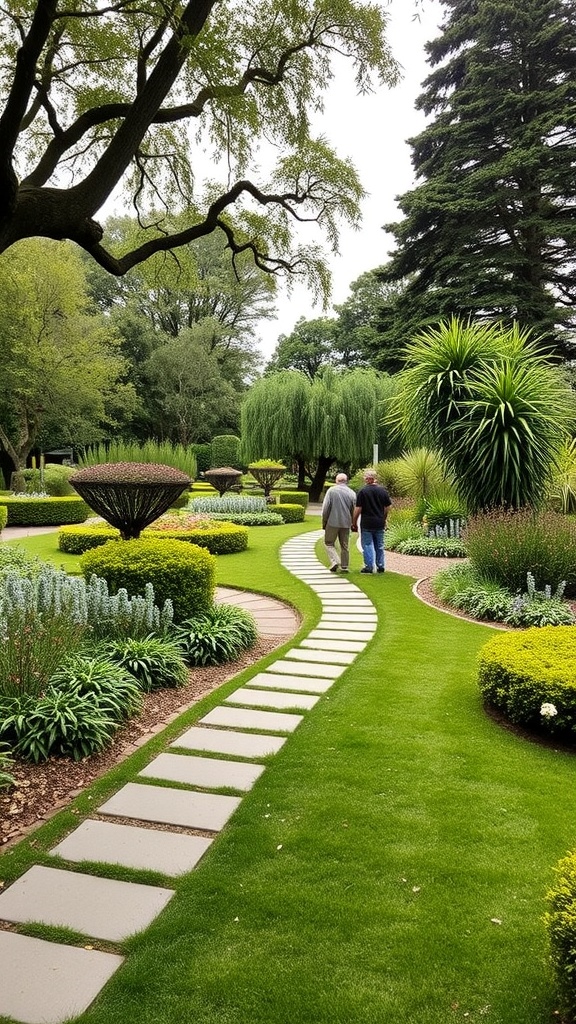
Creating a botanical garden that everyone can enjoy is key. The image shows a winding path surrounded by lush greenery, making it inviting for all visitors. Accessibility means ensuring that everyone, regardless of their mobility, can explore and appreciate the beauty of nature.
Wide, smooth pathways like the one in the image allow easy navigation for wheelchairs and strollers. This design choice encourages families and individuals with mobility challenges to visit. Incorporating benches along the path offers resting spots, making it easier for everyone to take their time and enjoy the surroundings.
Another important aspect is signage. Clear, easy-to-read signs help guide visitors through the garden. This is especially helpful for those who may need assistance or are unfamiliar with the layout. Thoughtful placement of these signs can enhance the overall experience.
Lighting is also essential. Well-lit areas ensure safety during evening visits and help everyone feel comfortable. The combination of natural beauty and practical design makes a botanical garden a welcoming space for all.
Incorporating Hardscape Elements
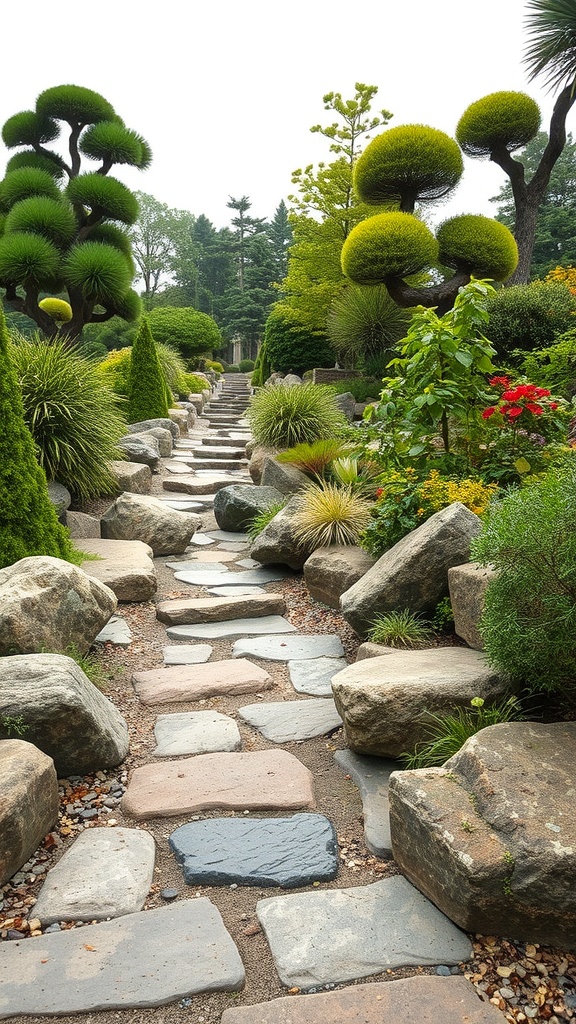
When designing a botanical garden, hardscape elements play a key role in shaping the space. The image shows a beautifully crafted stone pathway that guides visitors through lush greenery. This pathway not only provides structure but also enhances the overall aesthetic.
The stones vary in size and color, creating a natural look that blends seamlessly with the surrounding plants. This mix of textures adds depth to the garden, making it visually interesting. The pathway invites exploration, encouraging visitors to wander and discover different areas of the garden.
Incorporating features like rocks and stones can also help with drainage and soil stability. These elements are practical while still being attractive. They create a balance between the hard surfaces and the soft, vibrant plants, making the garden feel harmonious.
Using hardscape elements like this pathway can define spaces within the garden. It can lead to seating areas, water features, or specific plant collections. This thoughtful layout enhances the visitor experience, making it easy to navigate while enjoying the beauty of nature.
Incorporating Educational Signage
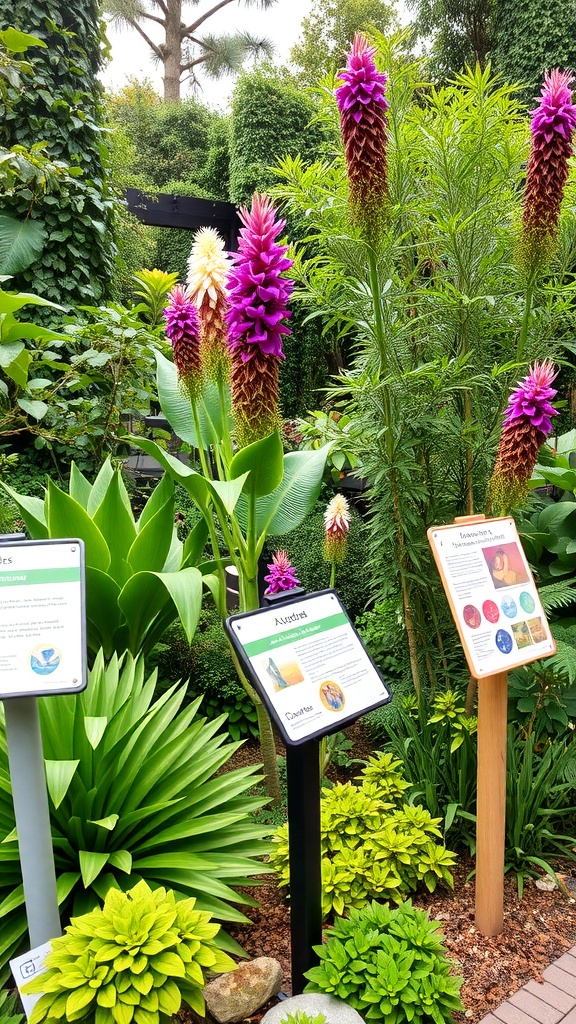
In a botanical garden, educational signage plays a key role in enhancing the visitor experience. The image shows a well-maintained garden with informative signs that provide details about the plants. These signs help visitors learn about different species, their origins, and their unique characteristics.
As people stroll through the garden, they can stop and read about the plants they encounter. This not only enriches their visit but also encourages a deeper appreciation for nature. The signs are designed to be clear and engaging, making it easy for everyone to understand the information.
Having educational signage also promotes conservation awareness. When visitors learn about the importance of various plants and ecosystems, they are more likely to support preservation efforts. This connection between knowledge and action is vital for the future of our environment.
Overall, incorporating educational signage in a botanical garden transforms a simple walk into an informative journey. It invites curiosity and fosters a love for plants and nature.
Creating Wildlife Habitats
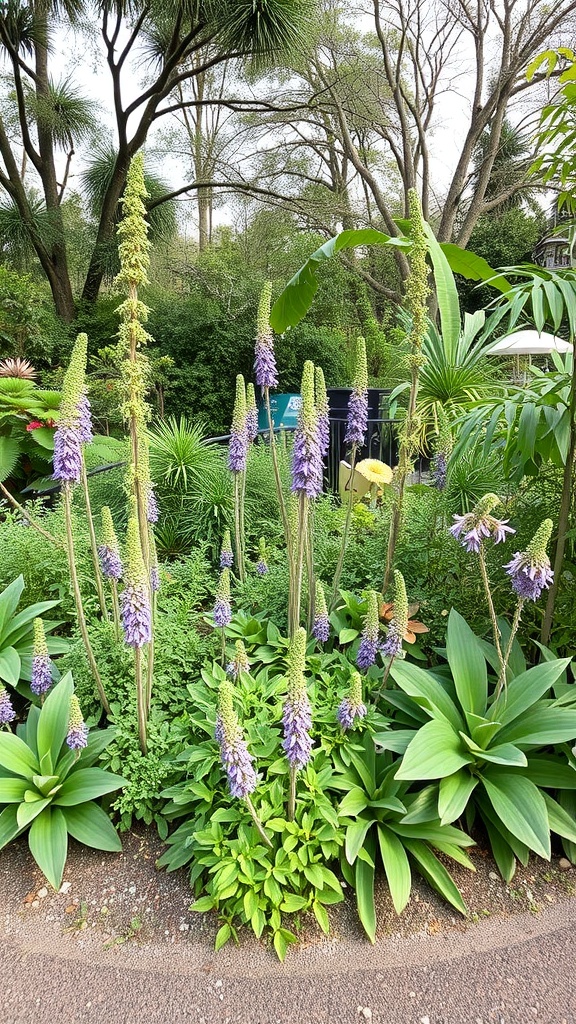
Creating wildlife habitats in a botanical garden is a rewarding way to support local ecosystems. The image showcases a vibrant display of flowering plants surrounded by lush greenery. These plants not only look beautiful but also provide essential resources for various wildlife.
Incorporating native plants is a great starting point. They are well-adapted to the local environment and attract pollinators like bees and butterflies. The tall flowering plants in the image can serve as excellent nectar sources, while the leafy greens offer shelter for small creatures.
Water features can enhance these habitats too. A small pond or fountain can attract birds and beneficial insects. The combination of diverse plants and water sources creates a balanced ecosystem, encouraging wildlife to thrive.
Creating pathways through the garden allows visitors to appreciate the beauty while minimizing disturbance to wildlife. It’s all about finding that balance between human enjoyment and nature’s needs.
Designing for Year-Round Interest
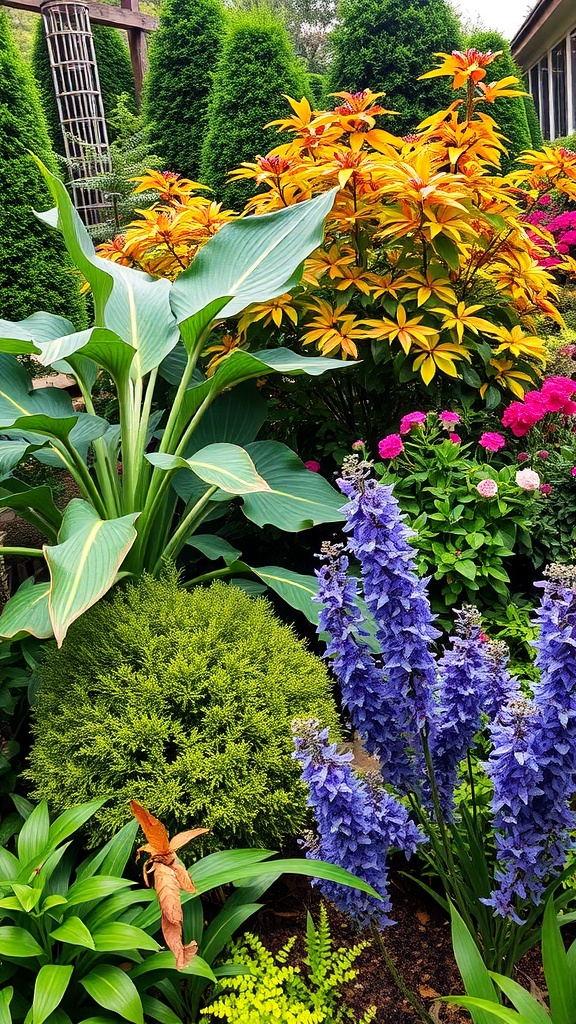
Creating a botanical garden that captivates throughout the seasons is a rewarding challenge. The image showcases a vibrant mix of plants, each contributing to the garden’s charm. Bright yellow and orange foliage contrasts beautifully with deep greens and purples, making it visually appealing.
Incorporating a variety of plants ensures that something is always in bloom or displaying interesting foliage. The lush greenery of the hostas and the striking blue flowers add layers of color and texture. This diversity not only pleases the eye but also supports local wildlife.
Consider using evergreens for structure and color in winter. They provide a backdrop for seasonal blooms and keep the garden lively even in colder months. Grouping plants with different blooming times creates a dynamic landscape that changes throughout the year.
Adding elements like trellises or decorative features can enhance the garden’s design. These structures can support climbing plants, adding vertical interest and maximizing space. Overall, a well-planned botanical garden can be a year-round delight.
